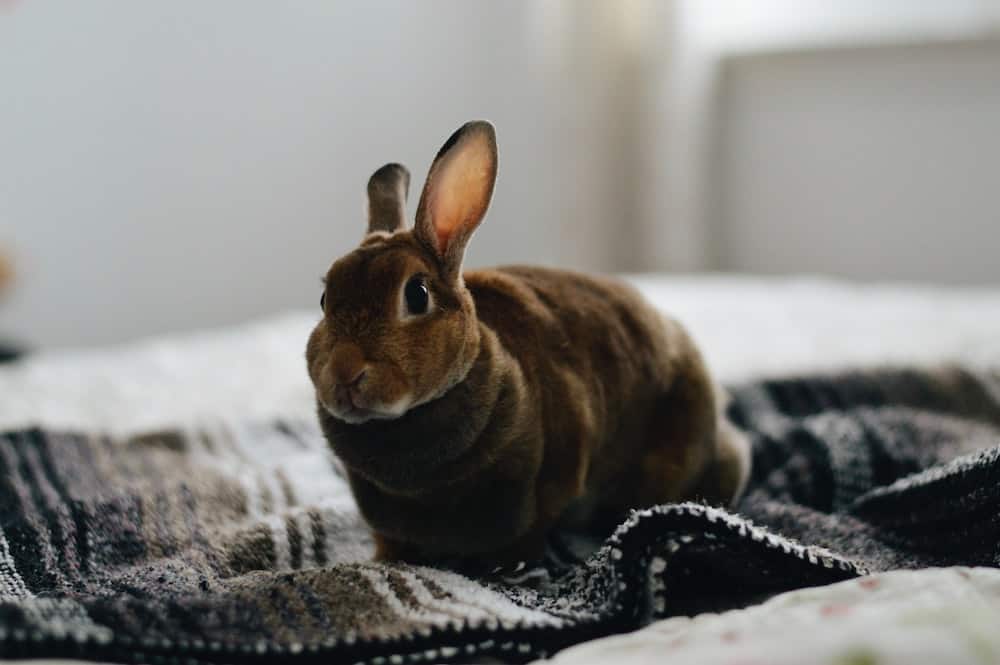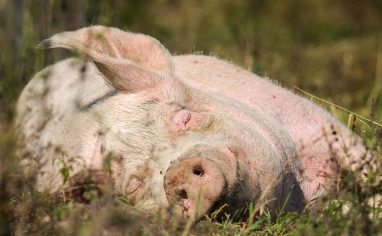
This resource was updated as part of the veterinary review process. It was originally published on October 2, 2020.

Veterinary Review Initiative
This resource has been reviewed for accuracy and clarity by a qualified Doctor of Veterinary Medicine with farmed animal sanctuaryAn animal sanctuary that primarily cares for rescued animals that were farmed by humans. experience as of April 2024. Check out more information on our Veterinary Review Initiative here!
New Resident? Conduct An Intake Evaluation!
If you are conducting an initial health evaluation on a new resident, check out our intake evaluation resource to learn about what you should check for and document!
Much like the common advice given to humans, it’s important to regularly evaluate the health of rabbitsUnless explicitly mentioned, we are referring to domesticated rabbit breeds, not wild rabbits, who may have unique needs not covered by this resource. with a routine health checkThe Open Sanctuary Project uses the term "health check" to describe health evaluations performed by caregivers who are not licensed veterinarians. While regular health checks are an important part of animal care, they are not meant to be a replacement for a physical exam performed by a licensed veterinarian. rather than waiting until a rabbitUnless explicitly mentioned, we are referring to domesticated rabbit breeds, not wild rabbits, who may have unique needs not covered by this resource. is showing signs of distress or illness. Conducting regular health checks will help you get to know what all aspects of a healthy rabbit look and feel like and will also help you establish a baseline for what is “normal” for each individual in your care. Not only this, but regular handling may help residents become more comfortable with restraint and human handling. Be prepared to check them over at least every six to eight weeks*! Rabbits who spend time outdoors†, especially during the warm season, will need much more frequent checks to prevent dangerous issues like flystrike and cuterebra. In addition to regularly scheduled health checks, plan to check rabbits for signs of these issues at least once a day during the warm season. For more information on why regular health checks are important, check out our resource here.
*A Health Check Every Six to Eight Weeks Means Daily Observations
Our recommendation to conduct routine health checks every six to eight weeks must be done in conjunction with daily observations. Caregivers should be trained to observe residents both for behaviors that are abnormal for the species and also for behaviors that are abnormal for each individual, keeping in mind issues that are common in a particular species and their warning signs. Thoughtful observation plays a crucial role in catching health issues before they progress into more serious situations. You can read more about daily observation for rabbit health and well-being here.
Residents With Challenging Backgrounds
Close daily observation can be difficult with certain individuals or groups who come from challenging backgrounds. They may be more likely to hide signs of illness or injury or, depending on their setup, may not allow you to come close enough to them to thoroughly assess their well-being on a regular basis. Challenging backgrounds may include individuals who are not socialized, have lived feral, or were abused or malnourished. If you care for individuals who come from a challenging background, it is imperative to make time to foster a bond of trust so careful observation is possible. Adjusting the frequency of health checks may be necessary for these individuals until they exhibit signs that they feel safe and you are confident that close daily observation is possible.
†Protect Your Rabbit Residents From RHDV!
If you are in an area where Rabbit Hemorrhagic Disease Virus (RHDV) is a concern, allowing unvaccinated rabbits to spend time outdoors puts them at grave risk of this highly contagious and highly fatal disease. There are many reasons why it may be in your rabbit resident’s best interest to live in your home, but if you want to explore the possibility of them spending time outdoors, be sure to talk to your veterinarian about if it is possible to do this safely and talk to them about getting your rabbit residents vaccinated against RHDV. Remember, RHDV isn’t the only risk rabbits face while outdoors – you must also ensure they are completely protected from predators!
Supplies
Before conducting a health check, it’s helpful to gather any supplies you may need and have them arranged nearby for easy access. Having everything you will likely need nearby can make the process go more smoothly and can reduce the amount of time the individual needs to be restrained. If you are performing a health check on someone with additional care needs, you may need other supplies in addition to those listed below. Otherwise, supplies to have on hand during rabbit health checks include:
- Recordkeeping supplies
- Nail trimmers (such as small dog or cat nail trimmers)
- Styptic powder or other blood stop product
- Gauze squares (non-sterile is typically fine, but there may be times when sterile gauze is necessary)
- Cotton swabs
- Exam gloves
- Rabbit-safe topical disinfectant (such as dilute chlorhexidine gluconate or dilute betadine)
- Saline flush
- Rabbit-safe ointments or creams such as silver sulfadiazine cream 1% (SSD)
- Cotton-tipped applicators
- Tweezers
- Scale
- Headlamp, penlight, or flashlight
- Washcloths and/or towels
- Brush/comb
- Rabbit-safe fly deterrent (during fly season)
Conducting The Health Check
Ask An Expert
Prior to regularly conducting rabbit health checks, you should have a veterinarian or compassionate care expert give you hands-on training in order to be the best rabbit health advocate possible. Being trained to rapidly distinguish abnormalities from normal anatomy and healthy conditions can be crucial in early health problem detection. The sooner you are able to bring concerns to your veterinarian, the sooner they’ll be able to work towards making a diagnosis and recommending any necessary interventions!
When In Doubt…
Unless you are a qualified veterinarian or have been trained to handle specific conditions, The Open Sanctuary Project strongly advocates that you promptly report any concerns you find during the course of a health check to your veterinarian (if you aren’t sure if what you are seeing is cause for concern or not, a more experienced caregiverSomeone who provides daily care, specifically for animal residents at an animal sanctuary, shelter, or rescue. may be able to help you, but if you are ever in doubt, we recommend erring on the side of caution and reaching out to your veterinarian). You should be the resident’s advocate, not their doctor! Additionally, routine health checks performed by a caregiver are not meant to be a replacement for a veterinary exam. The goal is to catch potential signs of concern as early as possible so you can bring concerns to your veterinarian. If necessary, they can then perform a more in-depth physical examination of the individual and can conduct diagnostic testing as needed.
Before beginning the actual health check, it’s a good idea to observe the individual without restraining them. Take note of their behavior, activity level, breathing, general appearance, how they are standing, how they are moving, and how they are interacting with their companions. Because the stress of the health check can cause a rabbit to have an elevated respiratory rate, you really want to pay attention to their breathing before you start handling them. When counting respirations, pay attention to their chest movements rather than their nostrils. The normal respiratory rate for a rabbit is 30-60 breaths per minute, but this can become much higher when they are stressed. Their breathing should be short, regular, and rapid, and there should be minimal effort when they breathe. Slower, deeper breaths are cause for concern, as is any crackling, wheezing, or other sounds. You can read more about “normal” versus potentially concerning rabbit resident observations here.
During regularly scheduled health checks, your goal is to check the rabbit’s whole body in a systematic order. It’s helpful to have a general order and routine that you follow each time because this can help ensure you do not miss a step. Some folks prefer to go from “top to tail,” but we recommend finding a system and order that works for you and your residents.
Safe Restraint
It’s always important to know how to safely restrain the species you care for in order to avoid causing injury or distress, but for rabbits, this is absolutely crucial. If not held properly, a rabbit may be able to kick their hindlimbs with so much force that they fracture their vertebrae and damage their spinal cord. It is imperative that their hind end always be supported to avoid this. We recommend performing as much of the health check as possible with the individual standing on a non-slippery surface (use a towel or bath mat to provide traction if needed). For the portions of the health check that cannot be done with the individual in this position (i.e., checking their underside), they must be held securely by someone who has been properly trained. They can place one hand under the rabbit’s front limbs to hold them while using the other hand to scoop up their back end. The individual can then be held with their back against the holder’s body to help provide additional support. Be sure to perform the health check with your resident’s comfort and well-being in mind – don’t force a rabbit to hold still or be in a certain position for the health check if it is stressful for them. If an individual is struggling while being held, set them down and try again when they are calmer.
Up next, we’ll go over important components of a rabbit health check:
Rabbits have a scent gland under their chin, and you may notice waxy build-up in this area, which can be gently removed with warm water and a cotton swab (avoid soaking the resident). Infected scent glands are possible, so if you have any concerns, please contact your veterinarian.
Starting at the base of the ears, feel for any lumps, scabs, swelling, or sensitivity, and work your way up the ear until you reach the tips. Then, look inside the ear. The skin should be pink and clean. A small amount of pale yellow wax may not be cause for concern and can be very gently removed with a cotton-tipped applicator, taking care not to push the wax deeper into the ear. Contact your veterinarian if you note scabbing, crusts, excessive wax, or malodorous discharge. Ear problems such as ear mites and ear infections are not uncommon and require treatment as prescribed by your veterinarian.
There should be no discharge or wetness around the eye (fur loss under the eye could be a sign of ocular discharge). While ocular discharge could be the result of an eye issue, it could also be a sign of dental disease. Veterinarian assessment is necessary to determine the cause and best course of action. Check their eyelids for redness, swelling, or signs that their hair is coming into contact with their eye (which will cause irritation). Like many species, rabbits have a nictitating membranea thin membrane found in many vertebrates at the inner angle or beneath the lower lid of the eye and capable of extending across the eyeball. If this is prominent, it could indicate the individual is stressed (if it is bulging, be sure to contact your veterinarian). You can gently pull the upper and lower eyelids away from the eye in order to check the color of the mucous membranes. This tissue should be pink and moist. Pale mucous membranes could be a sign of anemiaAnemia is a condition in which you don't have enough healthy red blood cells to carry adequate oxygen to the body's tissues. and are cause for concern, but overly red mucous membranes could also indicate an issue.
Unfortunately, eye issues are not uncommon in rabbits, and veterinarian assessment is necessary to determine the cause and treatment, so be sure to bring any concerns to your veterinarian.
Take care not to close or block their nostrils while checking their teeth (or during any other part of the health check!) As obligate nasal breathers, pinching or blocking their nostrils will cause them to panic.
Ensure that the rabbit’s nails are a reasonable length, trimming them as needed. A typical rabbit will have five nails on their front feet (this includes a dewclaw) and four nails on their back feet. Trimming a rabbit’s nails is very similar to trimming a cat’s or dog’s nails. Like cats and dogs, rabbits also have a sensitive area made of soft tissue in the center of their nail known as the quick. Cutting the quick by accident can be painful, bloody, and understandably stressful to the individual, so it’s important to be very mindful about how much you trim. In rabbits with dark nails, the quick may be more difficult to identify, but shining a light underneath the nail can help illuminate the quick.
If you accidentally draw blood, you can use a styptic pencil, styptic powder (such as Quick Stop), or cornstarch to stop the bleeding. Lacking these tools, you can also use a piece of toilet paper or cotton ball as if you’d nicked yourself shaving! If the bleeding doesn’t stop, you can use the tip of your finger to apply pressure for up to a minute, repeating until any bleeding stops.
With the rabbit in a seated position, their anus will be closer to the ground, with their genitals just above the anus. Check the genitals for any swelling, discharge, or irritation. The tissue of the penis and the vulva should be pink. Both males and females have scent glands that look like little pockets on either side of their genitals. These scent glands produce a waxy substance that is very strong smelling. If you notice a little bit of yellow wax in this area, cleaning might not be necessary. However, if the wax is dark in color or has becomed hardened, you can use a cotton-tipped applicator to very gently clean this out. Scent glands can become impacted and infected, so bring any concerns to your veterinarian.
Check the fur around their anus and genitals for any wetness or fecal matting. This area should be clean and dry. If you notice urine or fecal staining, be sure to consult with your veterinarian, as this is an indication something is amiss. In addition to consulting with your veterinarian to have the underlying cause diagnosed and addressed, you’ll need to clean them up (and keep them clean). Not only can a dirty bum lead to skin irritation, but it can also attract flies, putting them at risk of developing flystrike.
While cleaning is important, care must be taken when cleaning the individual so as to avoid unnecessary stress. A full bath is not recommended. Instead, opt for a wet or dry “butt-bath” to remove urine or feces. A dry bath involves applying a cornstarch-based baby powder (nothing with talc!) to the soiled area and working it into the fur. While cornstarch is safer than talc, you should still avoid using so much that it becomes airborne to limit the amount you or your rabbit residents breathe in. If needed, you can then use a comba fleshy crest on the head of the domestic chicken and other domesticated birds to gently comb out the cornstarch-coated messy areas. Be gentle! Rabbit skin is very delicate and can tear easily. Be sure to remove as much powder as possible and thoroughly clean the space of any powder when you are done. If the rabbit’s bum is very wet and messy, a dry bath may not be sufficient, in which case you may need to use warm water and a soft washcloth to clean soiled areas. You’ll need to dry them thoroughly (but gently) with a soft towel and then finish up with a blow dryer on the warm setting.
After checking the genital area, you can very gently feel the rabbit’s abdomen. Other than their nipples, you should not detect any lumps or bumps.
All rabbits will benefit from regular brushing. You’ll typically want to brush short-haired rabbits at least once a week, and this can be a great way for caregivers to bond with their rabbit companions. Long-haired rabbits will need to be brushed more often, perhaps even daily. Regardless of their hair length, all rabbits will need more frequent brushing when they are shedding. If care is not taken to help remove loose hair via brushing, the rabbit may ingest large amounts of fur while grooming which could result in gastrointestinal issues. When grooming rabbits, you can use a fine-toothed comb to check for fleas, looking for “flea dirt” (small black bits of debris which is actually flea feces).
To check for signs of other external parasites, run your hand along their back, starting at their tail and moving toward their head. By running your hand against their fur in this way, you’ll be able to visualize their skin and look for flea bites, scabs, crusts, or what appears to be dandruff. Flakes of dandruff may actually be fur mites, often called “walking dandruff.” Common sites include between the shoulders and on the back near the tail. Be sure to consult with your veterinarian if you see flakes of dandruff. They will likely recommend a skin scraping and microscopic evaluation to determine if the individual has fur mites or not.
Be sure to consult with your veterinarian if you notice any signs of external parasites. Not only can they diagnose the issue, but they can also recommend a rabbit-safe treatment (and appropriate dose). While your veterinarian will likely recommend extra-labelExtra-label use means that a drug is used in a way other than what is described on the label or package insert. If a drug is used in a different species than what it has been approved for, this is extra-label use. Other examples include using a drug to treat a different condition than it is approved for or administering it in a different way than the directions describe. Extra-label drug use can only occur within the confines of a valid veterinarian-client-patient relationship. use of a dog or cat product, not all products that are used in dogs and cats are safe to use in rabbits. Frontline (fipronil) is one example. This drug can cause fatal toxicity and should never be used on rabbits.
In addition to weighing your residents, you should also monitor their body condition. If you feel along their body, you should be able to feel their ribs, hips, and spine, but these should not be prominent and should feel rounded instead of sharp. If bones are hard to detect, this indicates that the individual is overweight, and if they are prominent, this is an indication they are underweight
Though it may seem like an overwhelming amount of factors to be aware of, once you’ve gotten to know a rabbit and what good rabbit health looks like, you’ll be an excellent rabbit health ally in no time!
Writing It All Down
As you may know, regular documentation is a critical part of responsible sanctuary animal care. In order to maximize the value of your rabbit health checks, we’ve developed a free printable rabbit health check form for sanctuaries and rescues!
SOURCES:
Rabbit Health Check: Signs of a Healthy Bunny | Best Friends
Temperature, Heart And Respiration Rates | House Rabbit Society
Red Urine: Blood or Plant Pigment? | House Rabbit Society
Rabbit Health Check-Ups | Winter Park Veterinary Hospital
Physical Examination Of Rabbits | The University Of Edinburgh
Ferrets, Rabbits, And Rodents Clinical Medicine And Surgery, 4th Edition
Fur Loss And Skin Problems In Rabbits: Common Causes And Treatments | Dana Krempels, PhD
BSAVA Manual Of Rabbits, First Edition
Rabbit Eye Problems And Treatments | Lafeber Company
Grooming Tips | House Rabbit Society
Pododermatitis In Rabbits – Sore Hocks | Bishops Stortford Veterinary Hospital
Bathing A Rabbit’s Messy Bottom | Dana Krempels, PhD
Cheyletiellosis (Walking Dandruff) in Rabbits | VCA Animal Hospitals








